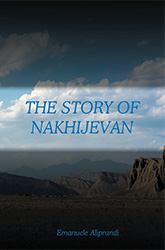Emanuele Aliprandi “The Story of Nakhijevan”, 2016
“The Story of Nakhijevan”

By Emanuele Aliprandi
MIA Publishers, Rome 2016
Historically, Nakhijevan has been one of the most prosperous regions under the rule of all Armenian kingdoms. Since the early history of the Armenian people until the 20th century, Nakhijevan was famous as a highly developed spiritual and cultural centre. In pre-Christian times the singers of Nakhijevan’s Goght’n province were very famous throughout Armenia. Then, in the early Christian period, the fi rst Armenian churches were founded in various areas of Nakhijevan. In this region, Mesrop Mashtots and his disciples preached and taught, gradually coming to the conclusion that Armenians needed their own alphabet. During the following centuries Nakhijevan became famous in one of the most signifi cant spheres of Medieval Armenian culture, that is. crafting stone crosses (khachkars).
After the collapse of Armenian statehood, the Nakhijevan region struggled to preserve its Armenian identity. In the late medieval period, the Armenian merchants of Agulis played an important role not only in regional trade deals, but also in the trade between the East and the West.
Nakhijevan has also continuously been subject to foreign invaders’ forays. Nevertheless, as much as they attempted, the geopolitical calculations of the Arab, Seljuk, Tartar, Turkmen, Ottoman and, later on, of Kemal-Bolshevik invaders, failed, and they were not able to remove the Armenian imprint from this region. The policy of the complete cleansing of Armenians and annihilation of all traces of Armenian culture and history from Nakhijevan was implemented after the region was annexed to a state created in the 20th century – Azerbaijan. Despite the fact that, according to the Moscow and Kars Treaties of 1921, Nakhijevan was to be a protectorate of Azerbaijan, the authorities of Soviet Azerbaijan initially took full control of the region and afterwards commenced to implement a policy of ethnic cleansing, whilst simultaneously conducting a fi erce campaign against the Armenian language. The authorities of the already independent Azerbaijan were not content with the complete ousting of the natives out of their homeland and took steps towards the full annihilation of all traces of the Armenian presence. Cemeteries, which were evidence of the physical existence of Armenians, as well as churches, which were part of the spiritual heritage in the area, were deliberately destroyed. The last stroke of this barbaric policy was the destruction of one of the last masterpieces of the Armenian culture in Nakhijevan – the stone crosses in Old Jugha Medieval cemetery.
Such was the fate of the Armenian autonomous region given to Azerbaijan by the will of the Bolsheviks. When nowadays in front of the whole world the authorities of Azerbaijan are promising high autonomy to another Armenian region – the Republic of Artsakh (Nagorno-Karabakh), it is the example of Nakhijevan that reveals the genuine motives of those promises to every reasonable human.
Attachments:
- Emanuele Aliprandi “The Story of Nakhijevan” (in English)
- Эмануеле Алипранди “История Нахиджевана” (in Russian)
Content
Noah’s Ark and Noah’s First Haven
The Cradle of Civilisation
Nakhijevan as Part of the Kingdom of Van (Biainili, Urartu)
Ancient History
The Holy Apostles Thaddeus and Bartholomew
Mesrop Mashtots and the Armenian Writing System
Structure of the Nakhijevan Region
The Medieval Cultural Heritage
Another Period of Invasions and Wars
Mural Art
Part of the Russian Empire
The First World War and the Establishment of New States in the Transcaucasus
The Methodical Alienation of Sharur-Nakhijevan and the Sovietisation of the Newly Founded States
Conclusion








